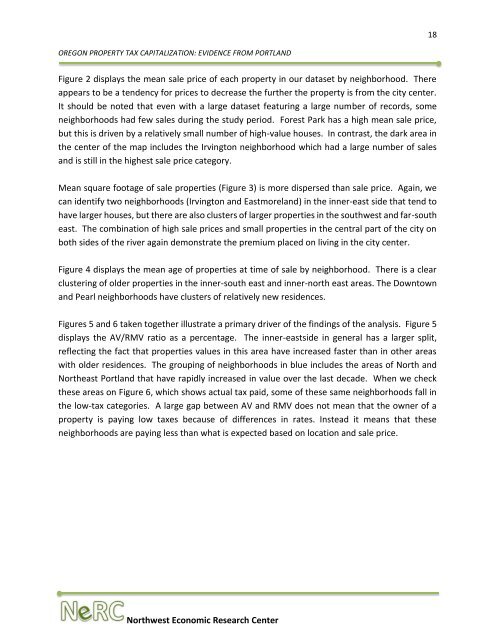Report-Oregon-Property-Tax-Capitalization-FINAL
Report-Oregon-Property-Tax-Capitalization-FINAL
Report-Oregon-Property-Tax-Capitalization-FINAL
Create successful ePaper yourself
Turn your PDF publications into a flip-book with our unique Google optimized e-Paper software.
18<br />
OREGON PROPERTY TAX CAPITALIZATION: EVIDENCE FROM PORTLAND<br />
Figure 2 displays the mean sale price of each property in our dataset by neighborhood. There<br />
appears to be a tendency for prices to decrease the further the property is from the city center.<br />
It should be noted that even with a large dataset featuring a large number of records, some<br />
neighborhoods had few sales during the study period. Forest Park has a high mean sale price,<br />
but this is driven by a relatively small number of high-value houses. In contrast, the dark area in<br />
the center of the map includes the Irvington neighborhood which had a large number of sales<br />
and is still in the highest sale price category.<br />
Mean square footage of sale properties (Figure 3) is more dispersed than sale price. Again, we<br />
can identify two neighborhoods (Irvington and Eastmoreland) in the inner-east side that tend to<br />
have larger houses, but there are also clusters of larger properties in the southwest and far-south<br />
east. The combination of high sale prices and small properties in the central part of the city on<br />
both sides of the river again demonstrate the premium placed on living in the city center.<br />
Figure 4 displays the mean age of properties at time of sale by neighborhood. There is a clear<br />
clustering of older properties in the inner-south east and inner-north east areas. The Downtown<br />
and Pearl neighborhoods have clusters of relatively new residences.<br />
Figures 5 and 6 taken together illustrate a primary driver of the findings of the analysis. Figure 5<br />
displays the AV/RMV ratio as a percentage. The inner-eastside in general has a larger split,<br />
reflecting the fact that properties values in this area have increased faster than in other areas<br />
with older residences. The grouping of neighborhoods in blue includes the areas of North and<br />
Northeast Portland that have rapidly increased in value over the last decade. When we check<br />
these areas on Figure 6, which shows actual tax paid, some of these same neighborhoods fall in<br />
the low-tax categories. A large gap between AV and RMV does not mean that the owner of a<br />
property is paying low taxes because of differences in rates. Instead it means that these<br />
neighborhoods are paying less than what is expected based on location and sale price.<br />
<strong>Oregon</strong>’s Electric Vehicle Industry<br />
Northwest Economic Research Center


